#Wild West Dynasty
Explore tagged Tumblr posts
Text
Top 10 Upcoming Survival Games That Look Fun
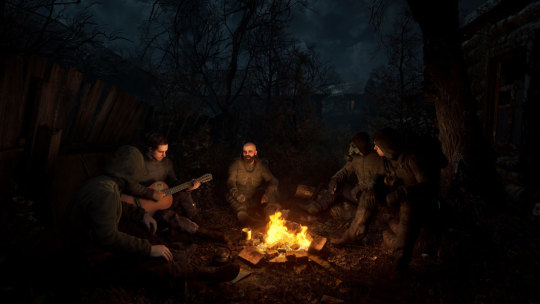
Survival games have grown in popularity in recent years, whether they are single player games, PvP survival games, or co-op survival games. Although there are already a plethora of survival games on the market, there are more on the way in 2023 and beyond that look fun and amazing.
Here are ten of the most exciting upcoming survival games: Top 10 Upcoming Survival Games That Look Fun | GAMERS DECIDE
#Wild West Dynasty#Palworld#Wanderlost#Nightingale#Frostpunk 2#Stalker 2: Heart of Chornobyl#The Lord of the Rings: Return to Moria#sons of the forest#Honeycomb#State of Decay 3
9 notes
·
View notes
Text
“Wild West Dynasty” to Enter Early Access on 16 February; New Trailer Released
“Wild West Dynasty” to Enter Early Access on 16 February; New Trailer Released | #gaming #Steam #PcGaming #Epic #PCgames
“Bluuuuuue shadoooooows on the traaaaaail…” Publisher Toplitz Productions recently announced that the genre-blending Wild West Dynasty is set to enter Early Access on Steam PC and the Epic Games Store on 16 February. Developed by Moon Punch Studio, Wild West Dynasty blends elements of open world sandbox, survival, story-driven adventure, roleplaying, city building and resource management, all…

View On WordPress
0 notes
Text
CGI-Trailer zu Wild West Dynasty bereitet auf den Early-Access-Start vor
Die Zeit, das Grenzgebiet zu erkunden, ist gekommen. Publisher Toplitz Productions und Entwickler Moon Punch Studio rufen alle Abenteurer und Cowboys auf, sich bereitzumachen. Das hoch erwartete Spiel “Wild West Dynasty” wird bald verfügbar sein. Es ist eine Mischung aus Open-World-Sandbox, Survival, Story-basiertem Action-Adventure, City-Builder mit Ressourcenmanagement und Rollenspiel. In nur…

View On WordPress
0 notes
Text
The Varieties of Chinese Mermaids
In the modern day, most people will think of the pearl-crying Jiaoren. However JIAOREN IS NOT THE PERFECT EQUIVALENT OF THE MERMAID in pre-modern folklore.
Chinese mermaids come in multiple types. Most of them can be found in the Chronicle of the Mountains and the Seas (Shan Hai Jing/山海經). Others can be found in the In Search of the Supernatural (Sou Shen Ji/搜神記) or Extensive Records of the Taiping Era (Taiping Guangji/太平廣記).
YUFU/MER-WIFE (魚婦): Zhuanxu was a god-emperor in legendary times, whose accomplishments included sending two of his sons to complete the separation of Heaven and Earth. When he died, fish ate his corpse, becoming half fish and half human women. They live in the Great Wilderness toward the west of China. They combine traits of humans, fish, and snakes. The Classic of Mountains and the Seas states: "There is a fish half-withered, it is Zhuanxu that died and then revived; when the winds blow northward, the sky whips up great geysers, snakes transform into fish, and those are mer-wives."
LINGYU/HILL FISH (陵魚,鯪魚): The Lingyu lived in the northern regions of China, either in the sea or mountain streams. They have human faces and limbs, but fish bodies. They are identified with Chinese giant salamanders or mud carp in the modern day. The Classic of Mountains and Seas states: "The nation of Guye is in the sea, among the Guye mountain range, surrounded by peaks to the southwest. There are great crabs are in the sea. There are Lingyu, which have human heads, feet, and hands, in the sea."
CHIRU/RED RU FISH (赤鱬): The Chiru lived in mountain in the south of China. It was red all over, had a human face, and its call sounded like that of a shelduck or mandarin duck. Eating its flesh protected people from contracting scabies. They are identified with sockeye salmon in the modern day. The Classic of Mountains and Seas states: "Three hundred miles more to the east, there is the mountain called Blue Hill...The Ying Waters emerge from here. Within are many Chiru; their forms are like fish, yet they have human faces, and their cries are like that of a shelduck. Those that eat its flesh will never have scabies."
DIREN/DI PEOPLE (氐人): The nation of the Di People was in the South of China. They were human from the waist up and fish from the waist down. They might have been a mythologization of the real Di People, who lived in western China, spread out from Shaanxi to Gansu. They joined the confederation of nomadic peoples who conquered Northern China during the Sixteen Kingdoms period. The Baima people of Gansu believe themselves to be descended from the ancient Di. The Classic of the Mountains and Seas states: "The nation of the Di People is west of the Jianmu Tree. Its inhabitants have human faces but fish bodies, with no feet."
HAI RENYU/SEA MERMAID (海人魚): The Sea Mermaid lives in the East China Sea. They tend to be around five to six shaku tall. (4'7"-5'6" or 1.4-1.68 meters.) Their upper bodies were that of humans, and they were all very beautiful. Their skins were white as jade, and their tails had no scales, but were covered in fine rainbow-colored hairs. Their hair grew long and wild like horse manes. Their private organs were much like that of humans, and they often sought humans or were sought by humans as mates in coastal communities, where they would live in a pool on their spouse's property. Sometimes they had red feelers or fins on their elbows and backs. Their bodies could not be penetrated by blades, but their fats could be harvested after death to form ever-burning candles. Han Dynasty texts state: "Merfolk have a human-like form longer than one shaku. They are not fit for consumption. Their skins are rougher than those of sharks, and cannot be penetrated by saws. They have little holes on their neck that they breathe through...Their fat is used to light lamps in royal tombs because the fire will never extinguish." Extensive Records of the Taiping Era states: "Sea Mermaids are found in the Eastern Sea. The largest ones are five or six shaku long. They are shaped like humans, with the brows and eyes, mouths and noses, hands and fingers, and heads of beautiful women, lacking in no feature. Their flesh is white as jade, and they have no scales, but thin, soft, and sleek hairs of five colors about one or two inches in length. Their private organs were no different from those of ordinary men and women. Widows and widowers from coastal communities often acquire them and raise them in pools. They mate the same way humans do, and never harm humans."
LOTING YUREN/LOTING FISH-MEN (盧亭魚人): Loting Fish-Men were found in the south of China, mostly around the Guangdong, Macau, and Hong Kong regions. They had humanoid limbs and humanoid faces with yellow hair and yellow eyes, but scaly bodies with fish tails. They lived mostly in the water, feeding on fish, but also built houses from mussel shells, and their favorite snack was chicken blood. They were a mythologization of the Tanka People, a southern Chinese pariah class who were once forced to live on their boats, as well as the Semang People. Ming Dynasty texts state: "The Jin Dynasty rebel Lu Ting was defeated and fled into the Guangdong region, where he lived a fugitive life on the water. After some generations, his descendants were unable to procure food or clothes, so they went about bare bodied and were called Loting. They would often sail out on the sea fishing for food, and they could all lie underwater for three or four days without dying, for they had already become fish." Qing Dynasty texts state: "Among the merfolk are the Loting Fish-Men, who are very numerous on Dayushan Island and the Wanshan Islands. Their adults are like humans, with male and female. Their hairs are dusky yellow and short and their eyes are also yellow, while their faces are black. Their tails are around an inch long. When they encounter humans they dive fearfully into the water. Often they would float along the waves, which would amaze people, who would they chase them. When a man who acquired one their females did the dirty with her, the fish-woman could not speak, only giggle. After a long while, she learned to wear clothes and eat grains. She was brought to Dayushan, where she went back to the water. These are the merfolk who do not harm men."
JIAOREN/SAMEBITO/SHARK-MEN (鮫人): Jiaoren are found in the South Seas. THEY ARE MER-SHARKS. THEY HAVE INKY BLACK BODIES, WILD HAIR, GLOWING GREEN EYES, AND SHARP TEETH. They are usually employed by dragon gods as weavers, capable of working tirelessly and spinning special waterproof silks. Their tears became pearls. They were first equated to Western mermaids by modern fantasy writers romanticizing the fact that they cried pearls.
WA WA YU/KIDDO FISH (娃娃魚): The Chinese Giant Salamander was often called a "mer-person" in the Ming and Qing dynasties, and described having a cry that resembled a baby's wail. To this day the colloquial name is still "Kiddo Fish".
421 notes
·
View notes
Text
As someone who longs for a version of JTTW that emphasizes the horror, this was a fun read-through of your observations! Many thanks for the submission and for sharing your thoughts on this week's reading, @nikofortuna
JTTW Chapter 46 Thoughts
Chapter 46 for the @journeythroughjourneytothewest Reading Group! TW: discussion of body horror and Psychological Horror under the cut, as in I will be giving my own creative descriptions on the three Immortals’ inner feelings as they realize they are in fact about to die.
The reminder of Sun Wukong being a hyperactive monkey makes this ever so real. He is very neurodivergent once more.
Also Tang Sanzang taking the initiative! Seems like character development to me.
It is very adorable how supportive Sun Wukong is. Also accurate, as far as I can remember that monk can’t lie to save his own life.
Hehe, centipede moustache for the Immortal.
Very nice that the silver tongue of the historical Xuanzang is shining through a bit in this round.
One could interpret Tang Sanzang’s words as him calling his disciples, who are monks for all intends and purposes, treasures.
I am not sure if it is just me but I don’t find all these, what should be instances of body horror, particularly unsettling at all. The situations seem really more funny than anything. Perhaps I am desensitized on that front from reading the likes of Junji Itou before. Though it might also be that I just have no great care for gory things, because to me simply having a body is horror in and of itself, so I kind of have to be used to that and external wounds are much less scary to me than diseases and all that harms from the inside.
Besides unless there is a component of psychological horror to it as well it is just not all that impactful in my eyes. Only when I actually imagine the Daoists realizing in horror they are about to die and think of their emotions and what must be going through their heads in those moments does it have a scary undertone to it.
Like imagine having your head cut off and while it is no big deal at first, after your head does not come back the first time you call, your calls become increasingly more desperate and terrified until your voice gives out because you are dead.
Or having your insides in your own hands and while that is not problem to you as you can just put them back, enter the hawk snatching them up and you are left to stare from the hawk in the sky back at your empty hands with the dreadful knowledge settling in that you are already dead.
Or feeling the oil start to boil and desperately trying to claw your way out of the cauldron, but to no avail until you are finally dead.
I’d argue the first one had the least horrific death as it was a quick one and I can imagine him being so focused on calling for his head that, even though the dread is there, he didn’t even quite process what exactly was going on having neither the focus nor time.
Meanwhile the second one has the focus to realize.
The last one was most clearly described as distressing in the novel but only in one small sentence. Either way this one has the time to realize. Plus this is extra harrowing because goats are notoriously good climbers.
Now those mental images, those read as truly scary to me.
#xiyouji#jtjttw submission#journey to the west#jttw#sun wukong#monkey king#tang sanzang#Tiger Strength Immortal#Deer Strength Immortal#Goat Strength Immortal#jttw reading group#jttw book club#death#psychological horror#this insight is made even more wild by the context#that the immortals INSISTED on the contests that would put them in their respective tang dynasty saw trap situations#talk about letting your hubris get the best of you
9 notes
·
View notes
Text
[Hanfu · 漢服]Chinese immortal Hanfu <西王母/Queen Mother of the West> Based On Yuan Dynasty Taoist Temple Mural<永乐宫/Yongle Palace>
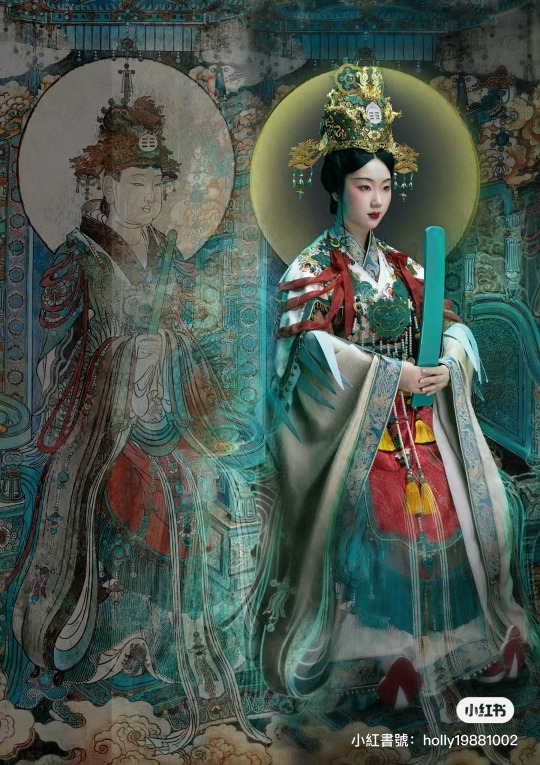
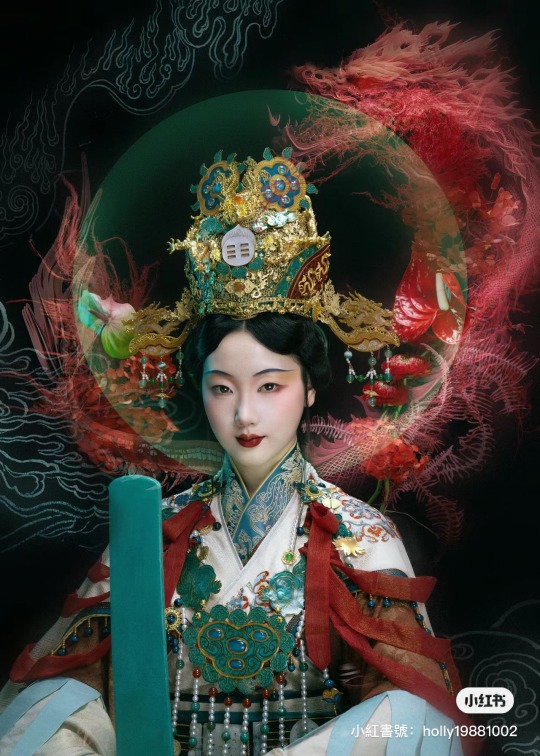
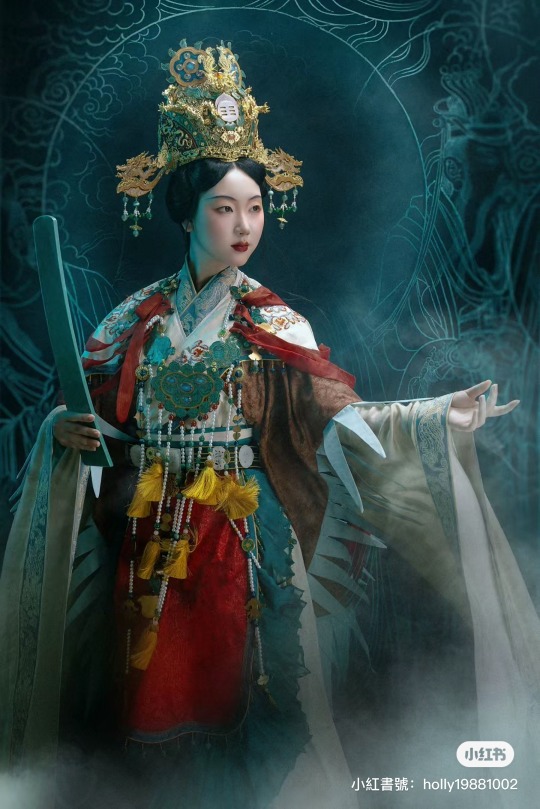
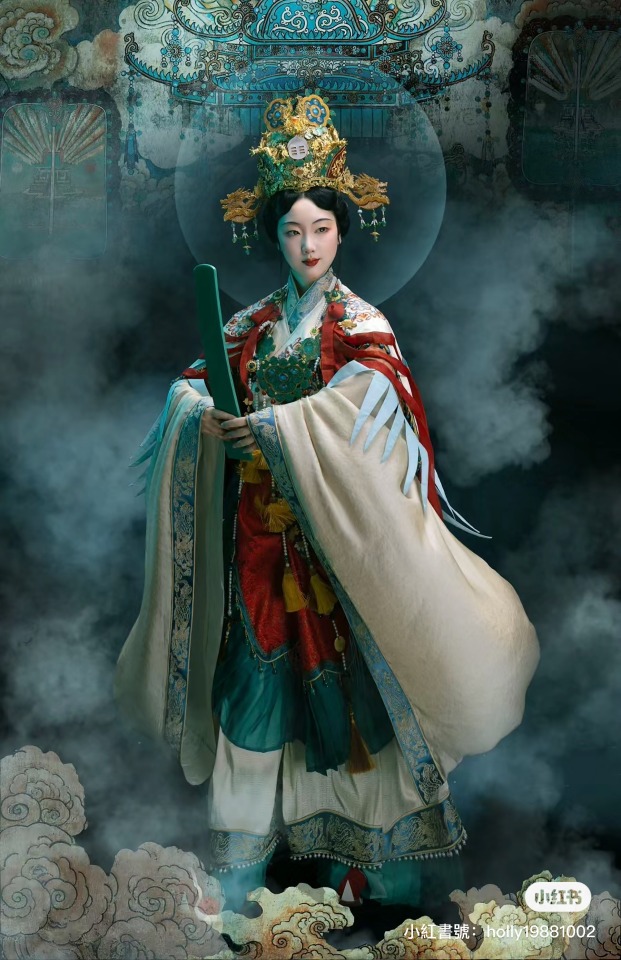
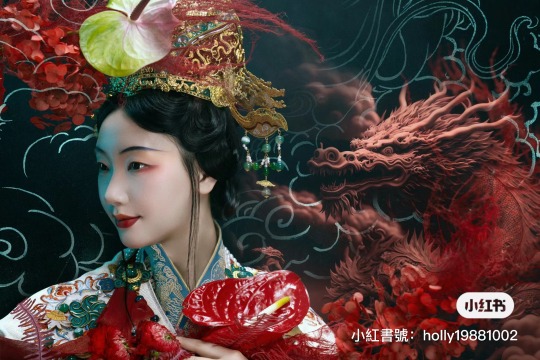
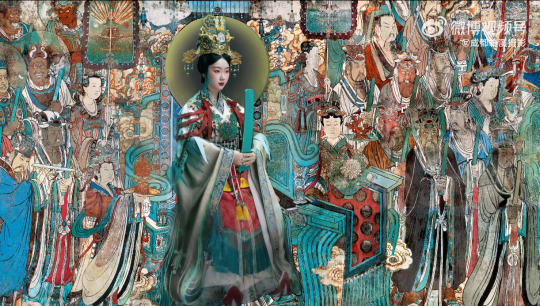
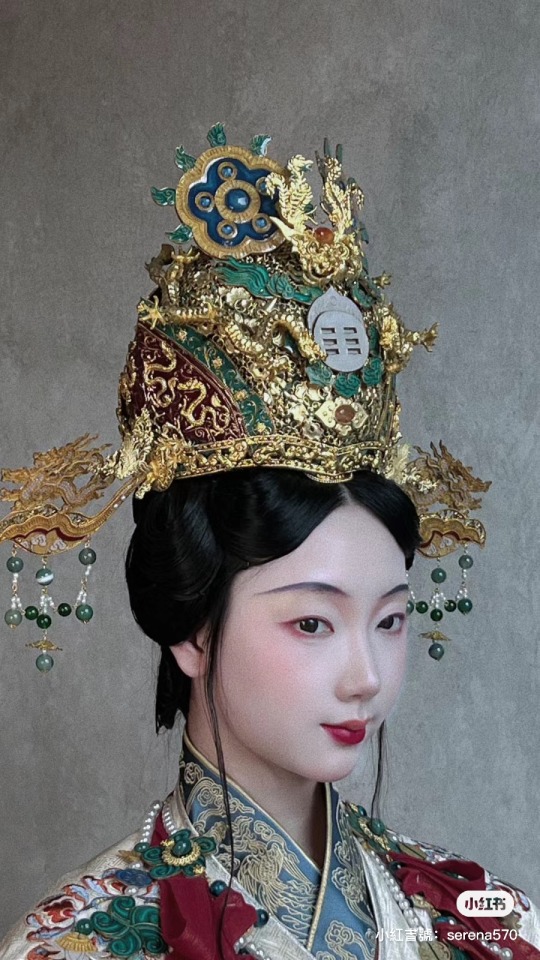
【Historical Artifacts Reference 】:
▶ China Yuan Dynasty Taoist Temple 永乐宫/Yongle Palace Mural
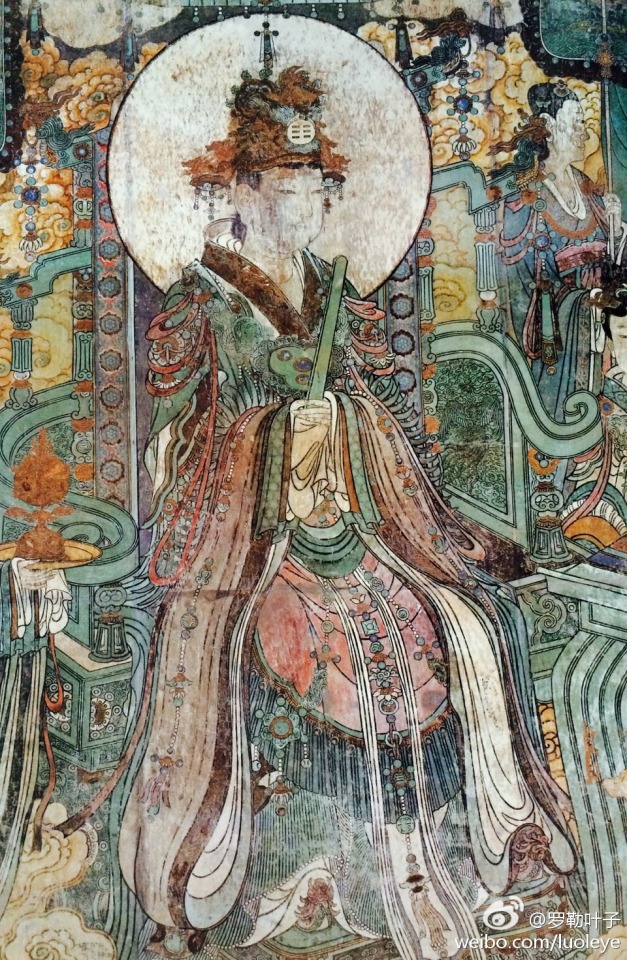
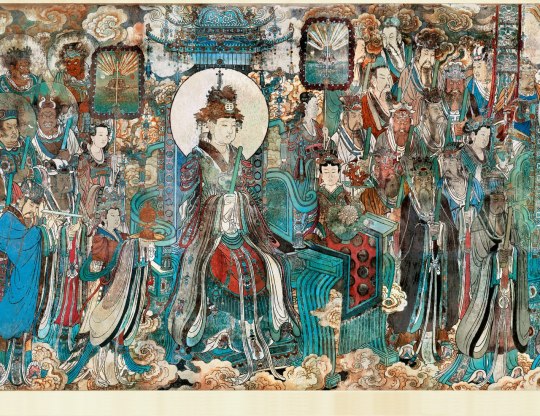
<西王母/Queen Mother of the West>
The Queen Mother of the West, known by various local names, is a mother goddess in Chinese religion and mythology, also worshipped in neighbouring Asian countries, and attested from ancient times.
The first mentions of the Queen Mother date back to the oracle bone inscriptions of the Shang dynasty (1766 – 1122 BCE). One inscription reads:
Crack-making on day IX (9th day), we divined. If we make offering to the eastern mother and the western mother, there will be approval.
Western Mother refers to an archaic divinity residing in the west. The exact nature of the Mother divinities in the Shang dynasty is unclear, but they were seen as powerful forces deserving of ritual by the people of the Shang dynasty. Originally, from the earliest known depictions of her in accounts like the Classic of Mountains and Seas during the Zhou dynasty, she was a ferocious goddess of death with the teeth of a tiger, who rules over wild beasts and sends down heavenly punishments such as pestilences. She was also mentioned as an authority ruling over other divinities such as Jiutian Xuannü, a goddess of war and sex. Other stories hold that she is a mountain goddess or a divine tigress. She is also popularly thought to have blessed the Eight Immortals with their supernatural abilities.
After her integration into the Taoist pantheon, she gradually took on associations with other aspects, such as immortality, as well.
The Queen Mother of the West is most often depicted holding court within her palace on the mythological Mount Kunlun, usually supposed to be in western China (a modern Mount Kunlun is named after this). Her palace is believed to be a perfect and complete paradise, where it was used as a meeting place for the deities and a cosmic pillar where communications between deities and humans were possible.At her palace she was surrounded by a female retinue of prominent goddesses and spiritual attendants. One of her symbols is the Big Dipper.
Although not definite there are many beliefs that her garden had a special orchard of longevity peaches which would ripen once every three thousand years,others believe though that her court on Mount Kunlun was nearby to the orchard of the Peaches of Immortality. No matter where the peaches were located, the Queen Mother of the West is widely known for serving peaches to her guests, which would then make them immortal. She normally wears a distinctive headdress with the Peaches of Immortality suspended from it.
Flourishing parasols, we reach the chronograms' extremity; Riding on the mist, I wander to Lofty Whirlwind Peak. The Lady of the Supreme Primordial descends through jade interior doors; The Queen Mother opens her Blue-gem Palace. Celestial people—What a Crowd! A lofty meeting inside the Cyan Audience Hall. Arrayed Attendants perform Cloud Songs; Realized intonations fill the Grand Empty Space. Every thousand years, her purple crabapple ripens; Every four kalpas, her numinous melon produces abundantly. This music differs from that at the feast in the wilderness— So convivial, and certainly infinite.— Wu Yun (Complete Tang Poems 1967, line 4942)
One of the earliest written references to the Queen Mother comes from the writings of the Taoist writer Zhuangzi (c. 4th century BCE):
The Queen Mother of the West obtained it [the Dao]... ...and took up her seat at Shao kuang. No one knows her beginning; no one knows her end.
Zhuangzi describes the Queen Mother as one of the highest of the deities, meaning she had gained immortality and celestial powers. Zhuangzi also states that Xiwangmu is seated upon a spiritual western mountain range, suggesting she is connected to not only the heavens, but also to the west.
Legendary encounters
In Tu Kuang-ting's text, he includes narrative accounts of the Queen Mother's encounters with legendary Chinese heroes. One such account narrates an encounter between the Queen Mother and Laozi (Lord Lao):
"In the 25th year of King Chao of the Chou dynasty (1028 BCE) …" "…Lord Lao and the realized person Yin Hsi went traveling…" "…on their behalf, the Queen Mother of the West explicated the Scripture of Constant Purity and Quiet."
In this account, the Queen Mother plays the role of Laozi's superior and is credited with the ultimate authorship of the Dao De Jing. This dichotomy of the Queen Mother as the superior is a characteristic of Shangqing Taoism, a goddess worshiping sect of Taoism of which Tu Kuang-ting was a master. There is also an account of a meeting between the Queen Mother and Laozi in Tang poetry.[18] This account however, being of traditional Taoist thought, has the Queen Mother taking an inferior role to Laozi, calling him "Primordial Lord" (the title of his highest manifestation) and pays homage to the sage.

<China Han Dynasty stone-relief showing 西王母/Queen Mother of the West from Sichuan,China>
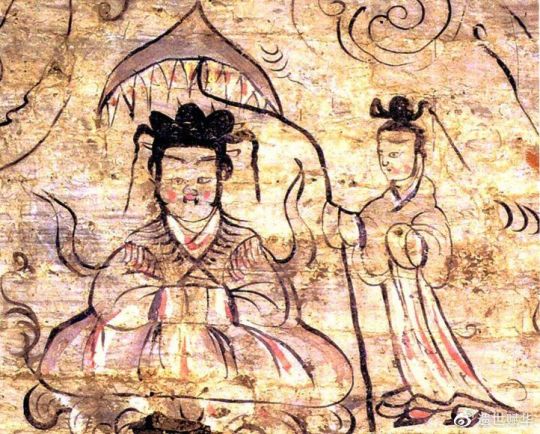
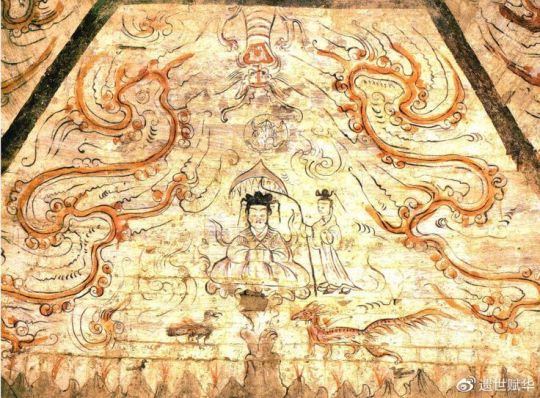
<China Wei and Jin Dynasties Mural showing 西王母/Queen Mother of the West>
————————
📸Photography post-production :@小何力
👗Hanfu & 👑Crown:@雁鸿Aimee
💄 Makeup:百丽 (临溪摄��)
👭Model:@清音音音音
🔗 Weibo:https://weibo.com/1648616372/O2R5bpBud
————————
#chinese hanfu#immortal hanfu#西王母/Queen Mother of the West#Chinese mythology#hanfu#hanfu accessories#hanfu_challenge#chinese traditional clothing#china#chinese#chinese history#china history#漢服#汉服#中華風#小何力#雁鸿Aimee#永乐宫/Yongle Palace
306 notes
·
View notes
Text
a.n.: part 5 (?). in the jjk!wild west au. first time writing for sukuna ✋😔 this is 1000% inspired by johnny cash
c.w.: mdni, 18+, language, sukuna is a warning in and of his own

“what’s a sweet little thing like you doing out at an hour like this?” is the first thing outlaw!sukuna ever says to you. he watches over you, staking an unnamed claim as you walk unbothered along side him.
you roll your eyes at him as you deliver your family’s produce to your neighbors. and the way your ass is all too perfectly sculpted in those boot cut jeans makes outlaw!sukuna harder than he’d ever care to admit.
yet outlaw!sukuna still finds himself stroking his cock and imagining your plump ass taking solitude over it. picturing how he’d let his hands bruise into your waist, stamped with the memory of your time together.
but he knew he’d seal his own fate getting with you. as the child of the towns greatest dynasty and family friend of the deputy sheriff, for outlaw!sukuna, thrusting up into you burnt in a sickly sweet way.
you found yourself in a rebellious era, finding solitude in the unknown. and outlaw!sukuna was just the antidote you needed.
and outlaw!sukuna wallowed in it, cuffing over your mouth as you moan out his name in pleasure. it’d spell trouble for the both of you but damned you’d be if you didn’t let that son of a bitch know how good he’d make you feel.
“fuck, doll. such a naughty girl and so, so good for me.” outlaw!sukuna whispers in your ear. you’re only able to manage out a whine, marinating in the way his cock hits just the way you need it to.
the second you say “feels too good, ‘kuna!” as he ruts deep into your pussy, outlaw!sukuna is a man done for. while he’s one to take the lead, hearing your moans makes him want to fold into a million timy pieces.
“such a filthy fucking slut. my fucking slut.” outlaw!sukuna praises, knowing he’s approaching his own end. you melt into him, reaching your high as you cum all over the town bad boys cock.

174 notes
·
View notes
Text
Assume that any and all language barriers can be overcome, be it through translators or other magical means.
Some reading to help you decide: Murasaki Shikibu - Japanese, author of The Tale of Genji, widely regarded as one of the first novels. Chrétien de Troyes - French, wrote in Lancelot, Percival, and other parts of Arthurian myth. Baroness Emma Orczy - British/Hungarian, creator of The Scarlet Pimpernel, who was the very first superhero/masked vigilante. Wu Cheng'en - Chinese, author of Journey to the West, one of the Four Classic Chinese Novels. Sappho of Lesbos - Greek, regarded as one of the greatest lyric poets of Ancient Greece. Abu Nuwas - Abbasid, foremost representative of the developing Arabic poetic form, and the only person in this poll to appear in One Thousand and One Nights. Mary Shelley - English, best known for writing Frankenstein; or The Modern Prometheus. Oscar Wilde - Irish, poet and playwright, author of The Picture of Dorian Grey and The Importance of Being Earnest. Li Qingzhao - Chinese, one of the greatest poets of both the Song Dynasty and Chinese history. Alexandre Dumas - French Creole, author of The Three Musketeers and The Count of Monte Cristo. Edith Pargeter - English, author of historical fiction and most well-known for her medieval detective series The Cadfael Chronicles.
108 notes
·
View notes
Photo

History of Assyria
The foundation of the Assyrian dynasty can be traced to Zulilu, who is said to have lived after Bel-kap-kapu (c. 1900 BCE), the ancestor of Shalmaneser I. The city-state of Ashur rose to prominence in northern Mesopotamia, founding trade colonies in Cappadocia. King Shamshi-Adad I (1813-1791 BCE) expanded the domains of Ashur by defeating the kingdom of Mari, thus creating the first Assyrian kingdom.
With the rise of Hammurabi of Babylonia (c. 1728–1686 BCE) and his alliance with Mari, Assyria was conquered and reduced to a vassal state of Babylon.
Middle Assyrian Period
In the 15th century BCE, Hurrians from Mitanni sacked Ashur and made Assyria a vassal. When Mitanni collapsed under pressure from the Hittites in Anatolia, Ashur again rose to power under Ashur-uballit I (1365-1330 BCE). He married his daughter to the Kassite ruler of Babylon with disastrous results: The Kassite faction in Babylon murdered the king and placed a pretender on the throne. Ashur-uballit promptly marched into Babylonia and avenged his son-in-law.
Shalmaneser I (1274-1245 BCE) declared that Assyria was no longer a vassal of Babylon and claimed supremacy over western Asia. He fought the Hittites in Anatolia, conquered Carchemish, and established more colonies in Cappadocia. His son Tukulti-Ninurta I (reigned 1243–1207 BCE) conquered Babylon, putting its King Bitilyasu to death, and thereby made Assyria the dominant power in Mesopotamia. He ruled at Babylon for seven years and assumed the old imperial title "king of Sumer and Akkad". During a Babylonian revolt, he was murdered by his son, Ashur-nadin-apli. Babylon was once more independent from Assyria.
Tiglath-pileser I (1114-1076 BCE), one of the great conquerors of Assyria, extended the remaining empire to Armenia in the north and Cappadocia in the west. He hunted wild bulls in Lebanon and was presented with a crocodile by the Egyptian pharaoh.
Little is known of Tiglath-pileser's direct successors, and it is with Ashurnasirpal II (883-858 BCE) that our knowledge of Assyrian history continues. The empire of Assyria was again extended in all directions, and the palaces, temples, and other buildings raised by Ashurnasirpal II bear witness to a considerable development of wealth and art. Nimrud (also known as the Biblical city of Calah or Kalakh) became the favorite residence of the monarch, who was distinguished even among Assyrian conquerors for his revolting cruelties. His son, Shalmaneser II (1031-1019 BCE) continued the expansion of Assyria and even further militarized the country.
When Nabu-nazir ascended the throne of Babylon in 747 BCE, Assyria was in the throes of a revolution. In 746 BCE Calah joined the rebels, and the rebel leader Pulu took the name of Tiglath-pileser III, seized the crown, and inaugurated a new and vigorous policy.
During the Middle Assyrian Period, the cities of Ashur, Nimrud, and Nineveh rose to prominence in the Tigris River valley. Babylon remained the most important and probably the largest city of the period.
Continue reading...
57 notes
·
View notes
Text

Chinese Ghost Part 3:
Exploring the Many Types of Chinese Ghosts 👻
The earliest known classification of ghosts in China dates back to the Qin Dynasty, with records found on bamboo slips from the Shuihudi Tomb in Yunmeng, Hubei. In the Qin and Han dynasties, ghost culture was rooted in the belief that ghosts caused illness and misfortune. Medical knowledge was limited back then, so when someone got sick, they often turned to rituals and protective charms, blaming mysterious ailments on restless spirits.
One of the earliest ghost-related texts, called the Daybook (Rishu), includes a section titled “Interrogation,” which catalogs ghostly names, forms, and exorcism techniques. It opens with, “The interrogation of ghosts, the ones who deceive and harm the people, bringing calamity...must be countered to prevent disaster.” Ancient people believed that knowing a ghost's name and form was essential for defense against their dark influences. In total, the Daybook names 25 different types of ghosts—the earliest documented ghost classification in China!

Ghostly Types in Buddhism 🕯️
In Buddhist teachings, ghosts generally fall into three main types:
Malevolent Ghosts: These ghosts are intimidating and frightening, with wild red hair and green eyes. They can fly, disappear, and shapeshift. Known for causing harm and spreading fear, they’re the stuff of nightmares.
Hungry Ghosts: Trapped in perpetual hunger and thirst, hungry ghosts are thin and skeletal, with hollow eyes and disheveled hair. Starving for hundreds or even thousands of years, they’re considered the most oppressed spirits, living in constant suffering.
Benevolent Ghosts: Often resembling humans, benevolent ghosts are helpful and honorable spirits. They might intervene in moments of injustice or assist the vulnerable, earning respect and admiration.

Daoist Ghosts of Many Colors 🌈
In Daoism, ghosts play an even bigger role, and Daoist priests often interact with them during rituals. Ghosts are categorized by name and type, with “good” ghosts sometimes employed to ward off the malevolent ones.
Daoist texts, like the Daozang (Daoist Canon), list over 80 “natural” ghosts, each with a unique name. Here’s a look at some of the categories:
Directional Ghosts: Eight ghosts guard each cardinal direction (east, south, west, north, and the center), totaling 40. These “good” ghosts oversee armies of spirits, ready to defend against misfortune.
Time Ghosts: Ghosts linked to each combination of the heavenly stems and earthly branches (traditional Chinese timekeeping), creating 60 “time ghosts,” each with a specific name. These spirits are thought to bring bad luck if not properly recognized.
Seasonal Ghosts: There are 24 seasonal ghosts, with 12 appearing each month and 12 each day. These ghosts periodically visit the human world, causing illness or harm.
Elemental Ghosts: When the Five Elements (Wood, Fire, Earth, Metal, Water) fall out of harmony, elemental ghosts can emerge. Knowing their names is key to controlling them.
Gu (Enchanting) Ghosts: Nine ghosts specialized in spreading chaos and delusion throughout the world.
And there’s more: Daoist lore also includes miscellaneous ghosts, a wide-ranging category for any spirits that don’t fit neatly into other classifications. There are 17 of these, plus 36 wandering ghosts that roam the world, sowing trouble.
Each ghost has a name, often using rare or invented characters, which is one reason why many Daoist ghosts remain lesser-known. This vast array of ghost types highlights the detailed and complex beliefs in Daoism around spirits and their influe
55 notes
·
View notes
Text
April 12, Xi'an, China, Daci'en Temple/大慈恩寺 and the Giant Wild Goose Pagoda/大雁塔 (Part 1 - Temple and Architecture):

Daci'en Temple is famous in popular culture mainly for one reason: the monk Xuanzang/玄奘, or the real person who inspired the character of Tang Sanzang/唐三藏 (sometimes translated as "Tripitaka") in the novel Journey to the West/西游记. Xuanzang was in charge of Daci'en Temple after he returned to China in 645 AD from his journey throughout Central Asia and India. More on him later.
The temple is also known for two more things, first is its importance to Chinese Buddhism, as the temple is considered the cradle of the Consciousness-Only School (weishizong/唯识宗) and the Dharma Characteristics School (faxiangzong/法相宗)(both are part of Chinese Mahayana Buddhism), and second is the Giant Wild Goose Pagoda (built in 652 AD while Xuanzang was in charge of the temple).
The temple has been rebuilt over the years, and the current temple (excluding the pagoda) was mainly built in 1466, during Ming dynasty, thus the current temple consists of Ming-era architecture:


Drum and bell towers within the temple


Giant Wild Goose Pagoda in the distance

More pictures of the architecture. I have to say it's better preserved here than in other places so far...





Coming up to the Mahavira Hall/大雄宝殿 of the temple

As mentioned in the previous posts on Qinglong Temple, I avoided taking pictures of the Buddha statues as this is considered disrespectful. But because it's just hard to avoid including them in pictures of the architecture, the statues may be partially visible sometimes.


Approaching the Tushita Hall/兜率

More pics of the architecture, note the pattern on the windows, called chuangling/窗棂. This particular one is a "three-crossing"/三交 pattern, the highest grade of chuangling.
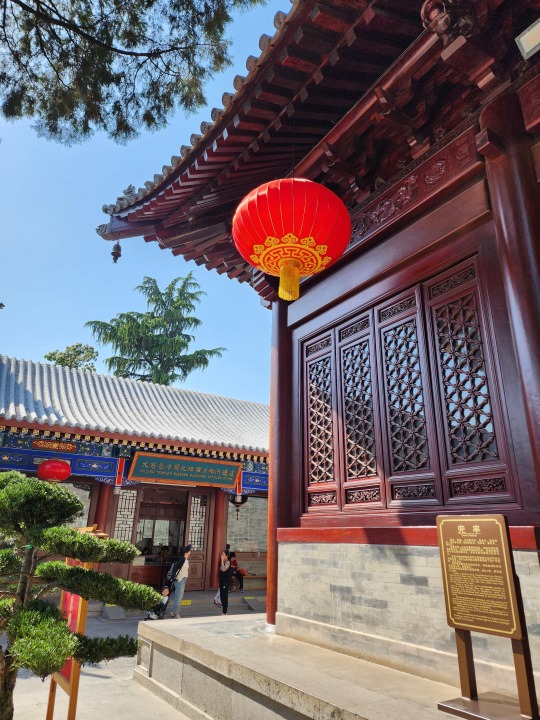

There were two visiting monks taking pictures of this relief behind Mahavira Hall, so it's probably okay to snap a picture of it. The interesting thing is the bian'e/匾额 above it, which says 人天欢喜 (right to left: "human and heaven rejoice together"). Usually it's "heaven" before "human" (天人), but here it's clearly "human" before "heaven".



The Guanyin Hall/观音殿. Guanyin is the Chinese name for Avalokitesvara. The smaller red lanterns are where visiters hang their wishes from:

And finally the Giant Wild Goose Pagoda, one of the landmarks of Xi'an. This pagoda was originally built to house all of the Buddhist texts and relics Xuanzang had brought back from India, and is the largest Tang-era brick pagoda remaining today. In Tang dynasty (618 - 907 AD), people who passed the imperial exams to become jinshi/进士 would tour around Chang'an on horseback with flowers in their hair and write poems before this pagoda, called "雁塔题名".
Before we entered the temple, I could hear a weird jingle-jangle from across the street, but it was only when we came up to the pagoda that I realized where the sound was coming from. There were bells hanging from every corner of every level of the pagoda, and they were pretty loud for their size.

Since it was pretty hot outside that day, to avoid possible heat stroke we didn't attempt to climb the pagoda (I don't think there's air conditioning inside considering that this pagoda is 1300+ years old.....). I think there were several important artifacts/relics inside? But I can find some pictures from online for part 3.



#2024 china#xi'an#china#daci'en temple#大慈恩寺#giant wild goose pagoda#大雁塔#xuanzang#玄奘#buddhist temple#chinese architecture#chinese history#mahayana buddhism#buddhism#architecture#history#culture
96 notes
·
View notes
Text
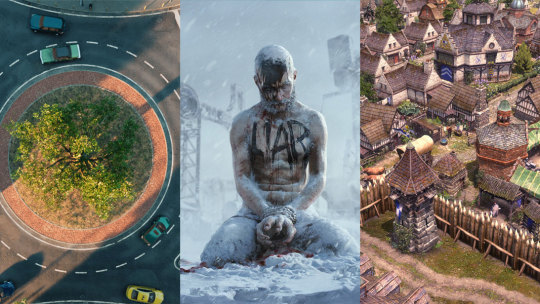
If you enjoy building cities, empires, or even towns, city-building simulation games are a popular genre. There are numerous upcoming city-building games with unique twists and challenges.
To find out the best upcoming City Building games 2023 and beyond here: [Top 20] Upcoming City Building Games 2023 And Beyond | GAMERS DECIDE
#Builders of China#Manor Lords#Laysara: Summit Kingdom#Pixelshire#Gord#Builders of Greece#Builders of Egypt#Pharaoh: A New Era#Wild West Dynasty#Post-Apo Builder#Celestial Empire#One Military Camp#Diluvian Winds#Scorchlands#Terra Nil#The Constructors#Farthest Frontier#Frostpunk 2#\Viking City Builder
6 notes
·
View notes
Text
I started writing an essay in the tags of a post that was not strictly related to this topic but started getting me thinking and realized I should just. Make my own post about this because I have kind of been sitting on this frustration for a while? And mmmm idk how to feel about this.
(For the record, the post that inspired this is this one.)
I want to make it clear UPFRONT that I am not knocking on ANYONE's interpretations of NHS or about having gender headcanons about a character in general. I think people can headcanon NHS as whichever gender they like because those interpretations are fun and exciting and I like to read about those too.
What I have been getting progressively iffy on, and am not entirely clear on how to express until I came across the above post is the idea that 'NHS is femme-coded because he has femme-coded hobbies' or 'NHS is very gender/gender nonconforming because he likes to paint and doesn't like exercise/practice his saber' or 'NHS is not very masc in comparison to his brother and people in his society put him down/are irritated with him/react to him differently because his gender presentation is more femme.'
And I think what's always kind of boggled me about interpretations like these that I've mentioned above is because...
Hobbies like keeping birds* and painting and calligraphy and poetry** and being well dressed and fashionable*** were strongly masculine coded scholar gentry hobbies for bored rich men**** in historical China. People react to NHS they way they do in text (at least from what I can understand of the social norms of the MDZS jianghu) because NHS is determined to be a particularly foppish dandy and also yknow, actively wailing about his many problems.
So, I think the tldr of this is that: NHS can be interpreted as whatever gender people would like! But his society and his peers and the other characters are not reacting to him in a certain way because he's femme-coded, they're reacting to him that way because he's an irritating asshole and kind of foppish (affectionate)
*keeping birds (as pets and not like, just raptors for hunting) was a rich man's hobby in Ancient China from at least the Zhou dynasty, though which birds were popular as pets (everything from parrots to orioles) differed depending on the dynasty, but the Ming and Qing dynasties were extremely big on pet birds in rich people's houses in particular.
**it is unclear if NHS is particularly good at say, painting or calligraphy OR poetry but the point is that he appears to like these things
***men's fashion has been a wild beast throughout the ages both in the east and the west, and men have done things for fashion like wearing gaudy archer's rings to show off archery skills they didn't have, high heels, Song dynasty men wore flowers in their hair, and my own personal unfavorite: the Qing Dynasty queue.
****the four gentlemanly arts were for example: qin qi shu hua -- playing the qin (music), weiqi (Go if you want to use the Japanese name for the game), shu (calligraphy), and hua (painting). See brief wikipedia summary about the four arts here. There were different things also included in the education of an aristocratic gentleman in pre-imperial China but we have no time to delve into that in this post. HMU for more info if you want it because I love to talk about historical things.
#nie huaisang#meta#my meta#again I'm not trying to say don't headcanon him a certain way#headcanon him whatever way you like!!!!#I too LOVE a good gender exploration#but people canonically react to him the way they do because he's IRRITATING AS FUCK (affectionate)#and not bc his hobbies are gnc#they're actually really gender conforming 😔😔😔
739 notes
·
View notes
Text
Jail Reunion
Summary:
Patriarch Subodhi has been captured by a demon. While he would be able to escape, any thoughts of escape flee when he sees who's in the cell across from him.
Notes:
This was just based on a fun fic idea I talked about in Discord, where Qi Xiaotian and Subodhi meet early, due to them and Sun Wukong being accused of a crime against a demon lord. Wukong manages to negotiate that he, his successor, and this "totally random but seemingly wise elder" will solve the mystery, leading to shenanigans.
Patriarch Subodhi was not angry at waking up in jail.
Annoyed was a better word. The cowards who had taken him did not have the courage to attempt to fight him- instead, he had gone out when rumors of a book, assumed to be lost during the scholar purges of the Qin dynasty, had turned up in a bookshop. Based on the throbbing on the back of his head, they had knocked him over the head.
Cowards.
Subodhi tested the chains wrapped around him, specifically the power-blocking cuffs around his wrists. The chains were tight, but the lock looked to be a simple one to pick. They had assumed that the cuffs would do the work. Their mistake. These kinds of cuffs focused on magic that had been present since birth. Subodhi had been born powerless, so the cuffs would have no effect-
"-I CAN'T BELIEVE I'M IN JAILLLLLL!"
Subodhi winced at the loud shriek from the cell across from his. Ever since the guard had stuffed his jailmates in there, one of the two had not stopped yelling and crying. A young man, based on his voice, if Subodhi had to guess. Once again, the older of the two started to soothe and comfort, his voice a low rumble with soft "buds" audible here and there.
"-PIGSY'S GONNA BE SO MAD- WHAT IF THE BAIL IS TOO MUCH-?!"
Bail? Subodhi scoffed. There was no bail in this prison. He suspected the demon wanted something from him and the two others. However, if the young man kept up with his wails, he would be executed.
Subodhi turned his head, preparing to say that.
Golden fur made his mouth click shut. He almost brushed it off as a hallucination, but Subodhi knew better. He wasn't concussed enough to hallucinate.
For the first time in several centuries, Subodhi was looking at Sun Wukong.
He looked older and more tired, but everyone aged. Like the first time they met, he wore simple clothing- a yellow and black hoodie and red jeans and black combat boots. His hair was left to flow wild down his back. It looked messy, as if someone had grabbed it. In front of him was a younger man, human with dark curls and big dark eyes that were welling up with tears.
All thoughts of escape fled Subodhi's mind.
He had been trying to get back in contact with his old disciple ever since the tripitaka had been brought back from the Buddha. He had been wrong about his old disciple, Subdohi could admit that. However, he could not bring himself to apologize and he had been too busy to seek him out.
Then, a century or so later, the monk had come, gathering stories of the journey, and Subodhi had seen the way. He had hoped that seeing the truth of who taught him would bring Wukong back, giving them a chance to talk.
It hadn't. Instead, Subodhi heard that Wukong had gathered as many copies of the Journey to the West as he could and destroyed them, but he could not gather all of them. His failure to do so had spread the story and not even that had brought Wukong to him. Instead, Subodhi found himself trying to arrange meetings by chance, hoping that one chance would net him a chance to corner his old disciple.
Except Wukong proved to be slippery.
This prison would not hold Wukong for long. However, here, Wukong couldn't run or jump out a window or disguise himself. If anyone asked, Subodhi was certainly not thinking of grabbing Wukong's arm and refusing to let go, but he would be lying through his teeth.
However, reason had to act first.
"Sun Wukong."
-_-
The minute his mentor's name was said, Qi Xiaotian was on the defense.
A lot of people had said Sun Wukong, and by now, Xiaotian knew that it was usually the prelude to an attack. The old man in the opposite cell looked frail and small, especially with the cartoonishly large chains wrapped around him, but Xiaotian knew better.
He looked up at Wukong, preparing his defensive speech, but the look on the monkey's face made him pause.
Wukong's eyes had gone large and wide. His mouth twitched, as if either to laugh or frown and he wasn't sure which. Then he looked away, staring at Xiaotian blankly. Then his brows furrowed together and he whirled around, mouth dropping open. The old man raised a brow and his mouth shut. He pressed his hands to his face and Xiaotian could see his eyes moving back and forth, as if he was reading something.
He opened his mouth again. "Urk," was what came out. His shoulders slumped and then he sighed, glancing at the old man like he expected something bad to happen.
The old man smiled. "Wukong," he said again, leaning forward.
The shutters promptly went up in his mentor's eyes, and Wukong whirled around at Xiaotian, smiling broadly at him. "You were saying, bud?"
"Uh..." Xiaotian craned his head to the side to see the old man's smile drop to instead look very annoyed.
Ah. He knew who this was. Tang had the same reaction whenever he bumped into his old professors, who usually had funny stories to share.
Qi Xiaotian smiled at Patriarch Subodhi right before his mentor blocked his view. "Look, bud, I know the other prisoners are really fascinating," his mentor said. "But focus on us. We got to keep our stern faces on so we can escape and save everyone else!"
"Including the old man?" He hated describing Patriarch Subodhi like that, but he just had to see-
"Including any old men that might be here!"
Subodhi groaned.
Oh boy.
#my writing#LEGO Monkie Kid#Monkie Kid#LMK#Master Subodhi#Sun Wukong#Qi Xiaotian#Patriarch Subodhi#fic#fanfic#fanfiction
55 notes
·
View notes
Text
I love how ambiguous Rimworld's setting is. It presents itself as realistic science-fiction in the style of Dune except with a noticeable "Wild West" vibe in the setting of a lawless land and a small, struggling colony on the frontier. Yet it still makes room for vampires, zombies, genetic abominations, rogue killer robots, insects engineered only for war, tribals, ultratech civilizations, spacers, eldritch horrors, wizards, psychics, techno-feudal dynasties, plant-killer weaponry, and Machine Gods. How? How is this all possible without some kind of magic involved?

Absolutely everything strange in the Rimworld universe can be A) attributed to the Archotechs, B) attributed to mechanites, or C) both. It's not like other science-fiction.
146 notes
·
View notes
Text
King Dany

Ever since A Dance With Dragons was new the fandom has been whining about Daenerys' struggle to rule in Meereen and how it proves GRRM must've been trying to show Daenerys is unfit to rule through depicting those struggles. Yet it is playing on the motifs from the most ancient origin of fantasy and GRRM's pre-Tolkien Boyshit sword and sorcery influence, Conan the Barbarian and his very first story about how he became Conan the King. It is a fundamental part of the Conan mythology and chronology that, after ages of wandering, Conan becomes king in the west and, after making his kingdom prosperous, goes back to wandering the world once more.
"Prospero," said the man at the table, "these matters of statecraft weary me as all the fighting I have done never did." "All part of the game, Conan," answered the dark-eyed Poitainian. "You are king—you must play the part." "I wish I might ride with you to Nemedia," said Conan enviously. "It seems ages since I had a horse between my knees—but Publius says that affairs in the city require my presence. Curse him! "When I overthrew the old dynasty," he continued, speaking with the easy familiarity which existed only between the Poitainian and himself, "it was easy enough, though it seemed bitter hard at the time. Looking back now over the wild path I followed, all those days of toil, intrigue, slaughter and tribulation seem like a dream. "I did not dream far enough, Prospero. When King Numedides lay dead at my feet and I tore the crown from his gory head and set it on my own, I had reached the ultimate border of my dreams. I had prepared myself to take the crown, not to hold it. In the old free days all I wanted was a sharp sword and a straight path to my enemies. Now no paths are straight and my sword is useless. "When I overthrew Numedides, then I was the Liberator—now they spit at my shadow. They have put a statue of that swine in the temple of Mitra, and people go and wail before it, hailing it as the holy effigy of a saintly monarch who was done to death by a red-handed barbarian. When I led her armies to victory as a mercenary, Aquilonia overlooked the fact that I was a foreigner, but now she can not forgive me. "Now in Mitra's temple there come to burn incense to Numedides' memory, men whom his hangmen maimed and blinded, men whose sons died in his dungeons, whose wives and daughters were dragged into his seraglio. The fickle fools!" "Rinaldo is largely responsible," answered Prospero, drawing up his sword-belt another notch. "He sings songs that make men mad. Hang him in his jester's garb to the highest tower in the city. Let him make rimes for the vultures." Conan shook his lion head. "No, Prospero, he's beyond my reach. A great poet is greater than any king. His songs are mightier than my scepter; for he has near ripped the heart from my breast when he chose to sing for me. I shall die and be forgotten, but Rinaldo's songs will live for ever. "No, Prospero," the king continued, a somber look of doubt shadowing his eyes, "there is something hidden, some undercurrent of which we are not aware. I sense it as in my youth I sensed the tiger hidden in the tall grass. There is a nameless unrest throughout the kingdom. I am like a hunter who crouches by his small fire amid the forest, and hears stealthy feet padding in the darkness, and almost sees the glimmer of burning eyes. If I could but come to grips with something tangible, that I could cleave with my sword! I tell you, it's not by chance that the Picts have of late so fiercely assailed the frontiers, so that the Bossonians have called for aid to beat them back. I should have ridden with the troops."
"And Dion thinks that crown will be given to him?" "Yes. The fat fool claims it by reason of a trace of royal blood. Conan makes a bad mistake in letting men live who still boast descent from the old dynasty, from which he tore the crown of Aquilonia. "Volmana wishes to be reinstated in royal favor as he was under the old regime, so that he may lift his poverty-ridden estates to their former grandeur. Gromel hates Pallantides, commander of the Black Dragons, and desires the command of the whole army, with all the stubbornness of the Bossonian. Alone of us all, Rinaldo has no personal ambition. He sees in Conan a red-handed, rough-footed barbarian who came out of the north to plunder a civilized land. He idealizes the king whom Conan killed to get the crown, remembering only that he occasionally patronized the arts, and forgetting the evils of his reign, and he is making the people forget. Already they openly sing The Lament for the King in which Rinaldo lauds the sainted villain and denounces Conan as 'that black-hearted savage from the abyss'. Conan laughs, but the people snarl."

16 notes
·
View notes